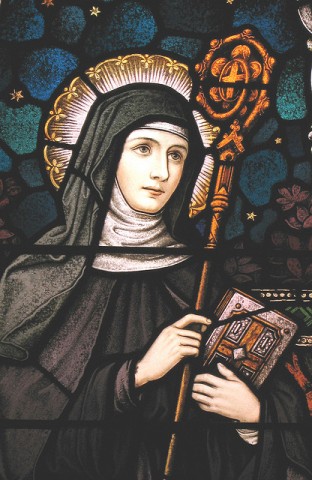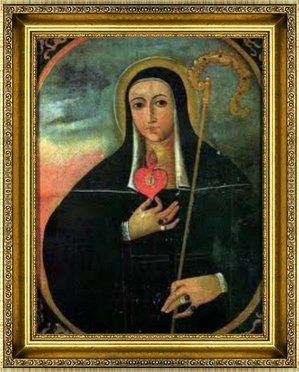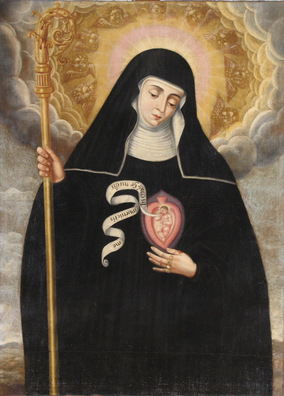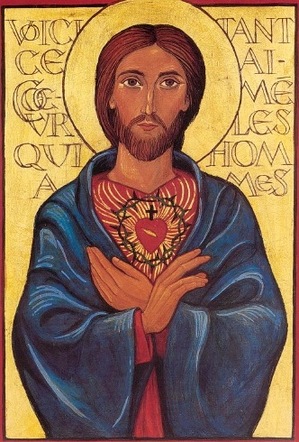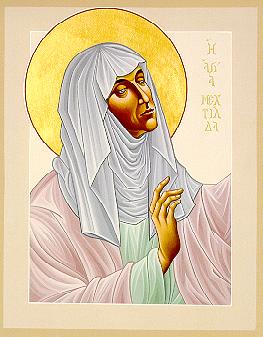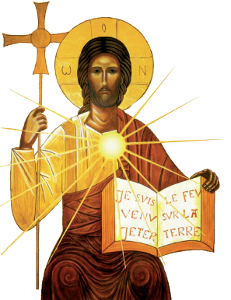 Two of my friends, one from France and another from the Swiss Cantons, hadn’t heard of the reasons for the devotion to Sacred Heart or of the persons of Saint Margaret Mary and Saint Claude. Even the image of the Sacred Heart was puzzling to them. Both of these people are young, and one is a convert. I don’t think it is an exaggeration to say that today’s feast is one of the most theologically profound of the year. The Preface for the Mass (Novus Ordo) reads:
Two of my friends, one from France and another from the Swiss Cantons, hadn’t heard of the reasons for the devotion to Sacred Heart or of the persons of Saint Margaret Mary and Saint Claude. Even the image of the Sacred Heart was puzzling to them. Both of these people are young, and one is a convert. I don’t think it is an exaggeration to say that today’s feast is one of the most theologically profound of the year. The Preface for the Mass (Novus Ordo) reads:
Father, all-powerful and ever-living God, we do well always and everywhere to give You thanks through Jesus Christ our Lord. Lifted high on the cross, Christ gave His life for us, so much did He love us. From His wounded side flowed blood and water, the fountain of sacramental life in the Church. To His open heart the Saviour invites all men to draw water in joy from the springs of salvation.
The Preface for the 1962 Missal reads:
It is truly meet and just, right and availing unto salvation, that we should in all times and in all places give thanks unto Thee, O holy Lord, Father almighty, and everlasting God; who didst will that Thine only begotten Son should be pierced by the soldier’s lance as He hung upon the Cross: that from His opened heart, as from a sanctuary of divine bounty, might be poured out upon us streams of mercy and grace; and that in His heart always burning with love for us, the devout may find a haven of rest, and the penitent a refuge of salvation.
Our theology of the Heart of Jesus revealed in this one phrase: “Unus militum lancea latus eius aperuit, et continuo exivit sanguis at aqua.” And we know from St. Justin Martyr (d. 165) that “We the Christians are the true Israel which springs from Christ, for we are carved out of His heart as from a rock.”
Ultimately, what the Solemnity of the Sacred Heart teaches us that we have been given the grace that we should not let the enemies of true religion set the agenda of life. So often the image of the divine secularists point to is an abstract god who has no relation to humanity in any way. The Christian’s response is that we believe in a God who is love, revealed in the Incarnate Son, Jesus. For the French there is the reminder of the Vendée and for the Mexicans there are the Cristeros…indeed, we have the Lord.
What follows is a anthology for the feast:
The Sacred Heart is shown wounded, encircled by a crown of thorns, surmounted by a Cross, and aflame with love for mankind. This symbol springs from the vision of the Sacred Heart had by St. Margaret Mary Alacoque.
“There is in the Sacred Heart the symbol and express image of the infinite love of Jesus Christ which moves us to love in return.” — Pope Leo XIII
The heart has always been seen as the “center” or essence a person (“the heart of the matter,” “you are my heart,” “take it to heart,” etc.) and the wellspring of our emotional lives and love (“you break my heart,” “my heart sings,” etc.) Devotion to the Sacred Heart of Jesus is devotion to Jesus Christ Himself, but in the particular ways of meditating on his interior life and on His threefold love — His divine love, His burning love that fed His human will, and His sensible love that affects His interior life. Pope Pius XII of blessed memory writes on this topic in his 1956 encyclical, Haurietis Aquas (On Devotion To The Sacred Heart).Below are a few excerpts which help explain the devotion:
54. …the Heart of the Incarnate Word is deservedly and rightly considered the chief sign and symbol of that threefold love with which the divine Redeemer unceasingly loves His eternal Father and all mankind.
55. It is a symbol of that divine love which He shares with the Father and the Holy Spirit but which He, the Word made flesh, alone manifests through a weak and perishable body, since “in Him dwells the fullness of the Godhead bodily.”
56. It is, besides, the symbol of that burning love which, infused into His soul, enriches the human will of Christ and enlightens and governs its acts by the most perfect knowledge derived both from the beatific vision and that which is directly infused.
57. And finally — and this in a more natural and direct way — it is the symbol also of sensible love, since the body of Jesus Christ, formed by the Holy Spirit, in the womb of the Virgin Mary, possesses full powers of feelings and perception, in fact, more so than any other human body.
58. Since, therefore, Sacred Scripture and the official teaching of the Catholic faith instruct us that all things find their complete harmony and order in the most holy soul of Jesus Christ, and that He has manifestly directed His threefold love for the securing of our redemption, it unquestionably follows that we can contemplate and honor the Heart of the divine Redeemer as a symbolic image of His love and a witness of our redemption and, at the same time, as a sort of mystical ladder by which we mount to the embrace of “God our Savior.”
59. Hence His words, actions, commands, miracles, and especially those works which manifest more clearly His love for us — such as the divine institution of the Eucharist, His most bitter sufferings and death, the loving gift of His holy Mother to us, the founding of the Church for us, and finally, the sending of the Holy Spirit upon the Apostles and upon us — all these, We say, ought to be looked upon as proofs of His threefold love.
60. Likewise we ought to meditate most lovingly on the beating of His Sacred Heart by which He seemed, as it were, to measure the time of His sojourn on earth until that final moment when, as the Evangelists testify, “crying out with a loud voice ‘It is finished.’, and bowing His Head, He yielded up the ghost.”Then it was that His heart ceased to beat and His sensible love was interrupted until the time when, triumphing over death, He rose from the tomb.
61. But after His glorified body had been re-united to the soul of the divine Redeemer, conqueror of death, His most Sacred Heart never ceased, and never will cease, to beat with calm and imperturbable pulsations. Likewise, it will never cease to symbolize the threefold love with which He is bound to His heavenly Father and the entire human race, of which He has every claim to be the mystical Head.
Devotion to the Sacred Heart has two elements: consecration and reparation:
We consecrate ourselves to the Sacred Heart by acknowledging Him as Creator and Redeemer and as having full rights over us as King of Kings, by repenting, and by resolving to serve Him.
We make reparations for the indifference and ingratitude with which He is treated and for leaving Him abandoned by humanity.
To carry out these general goals of consecration and reparation, there are quite specific devotions authorized by the Church.
Specific Devotions
From the earliest days of the Church, “Christ’s open side and the mystery of blood and water were meditated upon, and the Church was beheld issuing from the side of Jesus, as Eve came forth from the side of Adam. It is in the eleventh and twelfth centuries that we find the first unmistakable indications of devotion to the Sacred Heart. Through the wound in the side, the wounded Heart was gradually reached, and the wound in the Heart symbolized the wound of love.” (Catholic Encyclopedia)
St. John Chrysostom (b. ca. 347) in his 85th Homily on the Gospel of St. John wrote:
For “there came forth water and blood.” Not without a purpose, or by chance, did those founts come forth, but because by means of these two together the Church consisteth. And the initiated know it, being by water indeed regenerate, and nourished by the Blood and the Flesh. Hence the Mysteries take their beginning; that when thou approachest to that awful cup, thou mayest so approach, as drinking from the very side.
St. Margaret Mary Alacoque’s vision of the Sacred HeartThe waters of Baptism, and the Blood of the Eucharist, pouring forth from Christ’s side, brought the Church into existence just as Eve was formed from Adam’s side. And just as God took man and “breathed into his face the breath of life, and man became a living soul,” so at the Pentecost did the Holy Ghost come down over the Church and bring Her to life.
General devotion to the Sacred Heart, the birthplace of the Church and the font of Love, were popular in Benedictine and Cistercian monasteries, especially in response to the devotion of the Benedictine St. Gertrude the Great (b. 1256), but specific devotions became even more popularized when St. Margaret Mary Alacoque (1647-1690), a Visitation nun, had a personal revelation involving a series of visions of Christ as she prayed before the Blessed Sacrament. She wrote, “He disclosed to me the marvels of his Love and the inexplicable secrets of his Sacred Heart.” Christ emphasized to her His love — and His woundedness caused by Man’s indifference to this love.
He promised that, in response to those who consecrate themselves and make reparations to His Sacred Heart:
He will give them all the graces necessary in their state of life.
He will establish peace in their homes.
He will comfort them in all their afflictions.
He will be their secure refuge during life, and above all, in death.
He will bestow abundant blessings upon all their undertakings.
Sinners will find in His Heart the source and infinite ocean of mercy.
Lukewarm souls shall become fervent.
Fervent souls shall quickly mount to high perfection.
He will bless every place in which an image of His Heart is exposed and honored.
He will give to priests the gift of touching the most hardened hearts.
Those who shall promote this devotion shall have their names written in His Heart.
In the excessive mercy of His Heart that His all-powerful love will grant to all those who receive Holy Communion on the First Fridays in nine consecutive months the grace of final perseverance; they shall not die in His disgrace, nor without receiving their sacraments. His divine Heart shall be their safe refuge in this last moment.
“Take my yoke upon you, and learn of me; for I am meek and lowly in heart: and ye shall find rest unto your souls.” — Matthew 11:29
